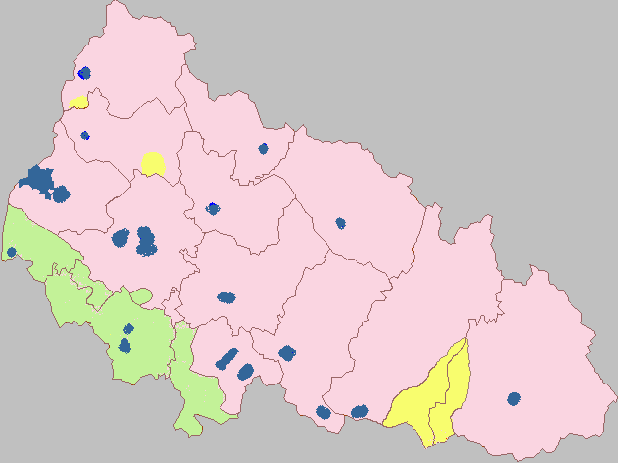- Hungarians in Ukraine
thumb|250px|Ethnic_map_of_Zakarpattia_Oblast_in_2001.legend|#4682B4|mixed Ukrainians (incl. Rusyns) andRussians ] The Hungarian minority ofUkraine consists of 156,600 people, according to the Ukrainian census of 2001. The minority is largely concentrated in theZakarpattia Oblast , where ethnic Hungarians form the largest minority at 12.1% of the population (12.7% when native language is concerned).History
Zakarpattia was part of
Kingdom of Hungary , a consituent part of theAustro-Hungarian Empire , until the latter's demise at the end ofWorld War I . This region was briefly part of the short-livedWest Ukrainian National Republic in 1918 and occupied byRomania at end of that year. It was later recaptured byHungary in the summer of 1919. After the defeat of the remaining Hungarian armies in 1919, the Paris Peace Conference concluded theTreaty of Trianon that awarded Zakarpattia to the newly formedCzechoslovakia as theSubcarpathian Rus , one of the four main regions of that new state, the others beingBohemia ,Moravia andSlovakia .cite book|title=Ukraine: A History|author=Subtelny, Orest |publisher=University of Toronto Press |year=2000|id=ISBN 0-8020-8390-0|pages=448]During the
World War II German occupation of Czechoslovakia , the southern part of the region was awarded toHungary under theFirst Vienna Award in 1938. The remaining portion was constituted as an autonomous region of the short-lived Second Czechoslovak Republic. After the occupation of Bohemia and Moravia onMarch 15 ,1939 and the Slovak declaration of an independent state, Ruthenia declared its independence (Republic of Carpatho-Ukraine) but it was immediately occupied and later annexed by Hungary.When the Soviet Army crossed the pre-1938 borders of Czechoslovakia in 1944, Soviet authorities refused to allow Czechoslovak governmental officials to resume control over the region, and in June 1945, President
Edvard Beneš formally signed a treaty ceding the area to theSoviet Union . It was then incorporated into theUkrainian SSR . After the break-up of the Soviet Union, it became part of independent Ukraine as the Zakarpattia Oblast.The minority's situation in independent Ukraine
Probably due to its interest in the ethnic Hungarian population in Zakarpattia,
Hungary was the first country to recognize Ukraine's independence.Árpád Göncz , who was president of Hungary at the time, was invited to visit the region, and a join declaration, followed in December 1991 by a state treaty, acknowledged that the ethnic Hungarian minority had collective as well as individual rights. The treaty provided for the preservation of the minority's ethnic, cultural, linguistic, and religious identities; education at all levels in the mother tongue; and the ethnic Hungarians' participation in local authorities charged with minority affairs.Kovrig, Bennett (2000) ‘Partitioned nation: Hungarian minorities in Central Europe’, in: Michael Mandelbaum (ed.), "The new European Diasporas: national minorities and conflict in Eastern Europe", New York:Council on Foreign Relations Press, pp. 19-80.]Minority rights
Residents in seven of
Mukachivskyi Raion 's villages have the option to learn theHungarian language in a school or home school environment. The first Hungarian College in Ukraine is in Berehovo, theII. Rákoczi Ferenc College .Organisation
The
Hungarian Democratic Federation in Ukraine (UMDSz) is the only nationally registered Hungarian organization. It was established in October 1991 by theHungarian Cultural Federation in Transcarpathia (KMKSz, which has suspended its membership since 1995), the Cultural Federation of Hungarians inLviv , and the Association of Hungarians inKiev . The Hungarian Cultural Federation in Transcarpathia is associated with the political partyKMKSz – Hungarian Party in Ukraine , which was established in February 2005. In March 2005, the Ukrainian Ministry of Justice also registered theHungarian Democratic Party in Ukraine upon the initiative of the UMDSz. [ [http://www.hhrf.org/htmh/en/?menuid=0407 Hungarian Government Office for Minorities Abroad] ]Demographics
The following data is according to the Ukrainian census of 2001.
References
External links
* [http://www.hhrf.org/kmksz/ Website of the Cultural Federation of Hungarians in Subcarpathia]
* [http://www.umdsz.uz.ua/start.html Website of the Hungarian Democratic Federation in Ukraine]
Wikimedia Foundation. 2010.

